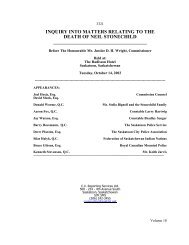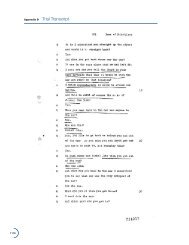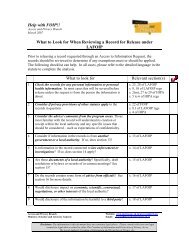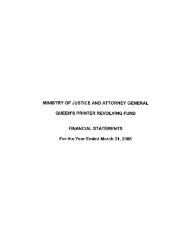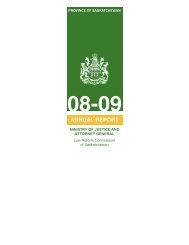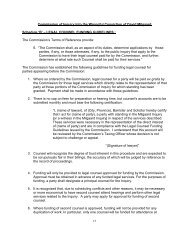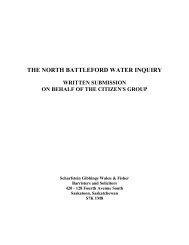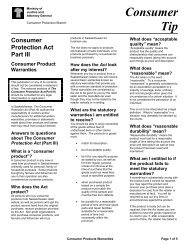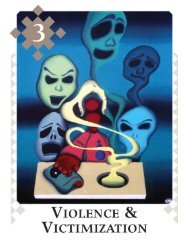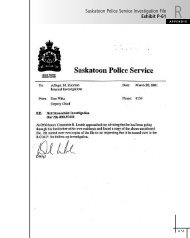Appendix K Memorandum of Law - s. 9(2) of the Canada Evidence Act
Appendix K Memorandum of Law - s. 9(2) of the Canada Evidence Act
Appendix K Memorandum of Law - s. 9(2) of the Canada Evidence Act
Create successful ePaper yourself
Turn your PDF publications into a flip-book with our unique Google optimized e-Paper software.
<strong>Appendix</strong> K <strong>Memorandum</strong> <strong>of</strong> <strong>Law</strong><br />
Justice Clute, a member <strong>of</strong> majority, stated as follows:<br />
… [section 9(1) <strong>of</strong> <strong>the</strong> CEA] in my mind did not make <strong>the</strong> production <strong>of</strong> <strong>the</strong> evidence taken at <strong>the</strong> inquest<br />
evidence <strong>of</strong> <strong>the</strong> facts <strong>the</strong>rein contained as pro<strong>of</strong> against <strong>the</strong> prisoner; and <strong>the</strong> trial Judge was bound, I think, if<br />
such evidence for <strong>the</strong> purpose <strong>of</strong> contradiction was admitted, carefully to caution <strong>the</strong> jury that <strong>the</strong>y were not to<br />
receive it as pro<strong>of</strong> <strong>of</strong> <strong>the</strong> facts pointing to <strong>the</strong> prisoner’s guilt, but solely as pro<strong>of</strong> <strong>of</strong> contradiction <strong>of</strong> <strong>the</strong> witness’<br />
statement at trial, and that <strong>the</strong>y ought not to convict <strong>the</strong> prisoner unless <strong>the</strong>y were satisfied that <strong>the</strong>re was<br />
sufficient evidence <strong>of</strong> his guilt without reference to that contained in <strong>the</strong> depositions <strong>of</strong> <strong>the</strong> witness at <strong>the</strong> inquest.<br />
…<br />
None <strong>of</strong> <strong>the</strong>se sections [i.e., section 9, 10 and 11 <strong>of</strong> <strong>the</strong> CEA (as <strong>the</strong>y read at <strong>the</strong> time)] was intended, in my<br />
opinion, to make that evidence <strong>of</strong> <strong>the</strong> facts <strong>of</strong> <strong>the</strong> case which would not o<strong>the</strong>rwise be evidence <strong>the</strong>re<strong>of</strong>; <strong>the</strong> plain<br />
intention <strong>of</strong> <strong>the</strong> statute being to enable counsel to attack <strong>the</strong> credibility <strong>of</strong> <strong>the</strong> witness by showing that he had<br />
previously made a different statement. 66<br />
In a concurring judgment, Justice Riddell stated as follows:<br />
Dr. Wigmore, in his able and exhaustive work on <strong>Evidence</strong>, gives a history <strong>of</strong> <strong>the</strong> practice <strong>of</strong> discrediting one’s<br />
own witness, vol. 2, pp. 1017 et seq., paras. 896 et seq., which I do not enter into. He says however, in<br />
answering an objection, that ‘we are not asked to believe his’ (<strong>the</strong> witness’s) ‘prior statement as testimony, and<br />
we do not have to choose between <strong>the</strong> two … We simply set <strong>the</strong> two against each o<strong>the</strong>r, perceive that both<br />
cannot be correct, and immediately conclude that he has erred in one or <strong>the</strong> o<strong>the</strong>r, but without determining<br />
which one … We do not in any sense accept his former statement as replacing his present one; <strong>the</strong> one merely<br />
neutralises <strong>the</strong> o<strong>the</strong>r … The prior contradiction is not used as a testimonial assertion to be relied upon.’ The<br />
learned author continues: ‘Prior self-contradictions, when admitted, are not to be treated as assertions having<br />
any substantive or independent testimonial value; <strong>the</strong>y are to be employed merely as involving a repugnancy or<br />
inconsistency; o<strong>the</strong>rwise <strong>the</strong>y would in truth be obnoxious to <strong>the</strong> Hearsay Rule:’ para. 1018.<br />
…<br />
I think that <strong>the</strong> evidence must be confined in its effect to <strong>the</strong> discrediting <strong>of</strong> <strong>the</strong> witnesses who had proved<br />
adverse.<br />
That evidence rightfully admitted for one purpose may not be evidence for ano<strong>the</strong>r is too clear for argument. 67<br />
Chief Justice Meredith dissented on <strong>the</strong> issue <strong>of</strong> whe<strong>the</strong>r <strong>the</strong> accused deserved a new trial based on<br />
<strong>the</strong> trial judge’s charge. However, he concurred with <strong>the</strong> majority on <strong>the</strong> evidentiary value <strong>of</strong> a prior<br />
inconsistent statement and added that <strong>the</strong> contents <strong>of</strong> a statement could be accepted as <strong>the</strong> truth if <strong>the</strong><br />
witness adopted <strong>the</strong> statement as true during cross-examination.<br />
Justice Lennox also dissented on <strong>the</strong> issue <strong>of</strong> whe<strong>the</strong>r <strong>the</strong> accused deserved a new trial based on <strong>the</strong> trial<br />
judge’s charge, but he concurred with Justice Riddell’s ruling on <strong>the</strong> evidentiary value <strong>of</strong> prior inconsistent<br />
statements. However, he also made <strong>the</strong> following comments on a jury’s ability to disregard <strong>the</strong> contents <strong>of</strong><br />
prior inconsistent statements:<br />
As to <strong>the</strong>se witnesses <strong>the</strong> initial and paramount question for <strong>the</strong> jury necessarily was: ‘Are <strong>the</strong>y telling <strong>the</strong> truth,<br />
can you believe <strong>the</strong>m?’ In <strong>the</strong>se circumstances, was it reasonable or unreasonable, nay, was it wrong or right,<br />
that <strong>the</strong> Judge, after cautioning <strong>the</strong> jury not to give heed to anything except what had fallen from <strong>the</strong> lips <strong>of</strong><br />
witnesses in Court, and referring to <strong>the</strong> evidence <strong>of</strong> <strong>the</strong>se witnesses at <strong>the</strong> trial and <strong>the</strong>ir previous statements,<br />
should say to <strong>the</strong> jury: ‘Now, it will be for you to come to a conclusion on <strong>the</strong>se statements, whe<strong>the</strong>r <strong>the</strong><br />
particular witness has told <strong>the</strong> truth to-day, or told it on ano<strong>the</strong>r occasion under oath.’ Surely it was a matter for<br />
66 Duckworth, supra note 65 at p. 330.<br />
67 Duckworth, supra note 65 at p. 339 and 340.<br />
2594



